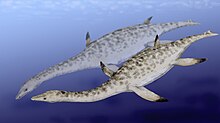Leptocleidia
Appearance
| Leptocleidians Temporal range: Cretaceous,
| |
|---|---|

| |
| Life restoration of the leptocleidian Nichollssaura borealis | |
| Scientific classification | |
| Domain: | Eukaryota |
| Kingdom: | Animalia |
| Phylum: | Chordata |
| Class: | Reptilia |
| Superorder: | †Sauropterygia |
| Order: | †Plesiosauria |
| Clade: | †Xenopsaria |
| Clade: | †Leptocleidia Ketchum and Benson, 2010 |
| Subgroups | |

Leptocleidia is a clade of plesiosauroids.[1] The group was erected in 2007 as Leptocleidoidea.[2] Although established as a clade, the name Leptocleidoidea implies that it is a superfamily. Leptocleidoidea is placed within the superfamily Plesiosauroidea, so it was renamed Leptocleidia by Hilary F. Ketchum and Roger B. J. Benson (2010) to avoid confusion with ranks. Leptocleidia is a node-based taxon which was defined by Ketchum and Benson as "Leptocleidus superstes, Polycotylus latipinnis, their most recent common ancestor and all of its descendants".[1]
References
[edit]- ^ a b Ketchum, H.F.; Benson, R.B.J. (2010). "Global interrelationships of Plesiosauria (Reptilia, Sauropterygia) and the pivotal role of taxon sampling in determining the outcome of phylogenetic analyses". Biological Reviews. 85 (2): 361–392. doi:10.1111/j.1469-185X.2009.00107.x. PMID 20002391. S2CID 12193439.
- ^ Druckenmiller, P.S.; Russel, A.P. (2007). "A phylogeny of Plesiosauria (Sauropterygia) and its bearing on the systematic status of Leptocleidus Andrews, 1922" (PDF). Zootaxa. 1863: 1–120. doi:10.11646/zootaxa.1863.1.1. ISBN 978-1-86977-262-8. ISSN 1175-5334. Archived from the original (PDF) on 2011-10-04.







